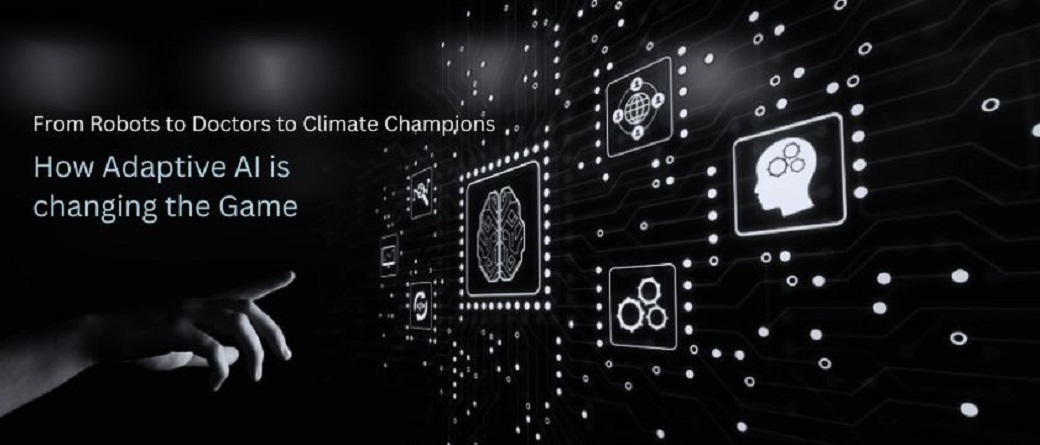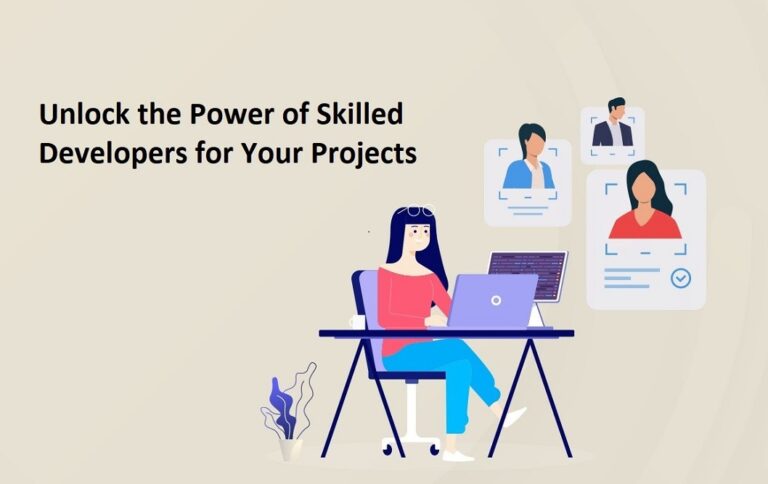New technologies powered by artificial intelligence (AI) are changing many parts of life. In particular, adaptive AI solutions that can learn and change are showing big potential across many industries.
Let’s look at how adaptive AI development solutions are improving robots, healthcare, climate science, and more.
Smarter Robots That Can Adapt
Robots keep getting smarter thanks to advances in adaptive AI development solutions. The AI helps robots learn new skills faster and get better at working in the real world.
For example, warehouse robots now use adaptive AI to improve at picking many types of items off shelves, even if the items move around or look a bit different.
The AI helps the robots identify and grab objects they have never seen before. This makes warehouse work faster and more efficient.
In factories, adaptive AI solutions help robot arms quickly change their movements to assemble custom products that come in hundreds of variations.
The AI sees patterns and gets more precise on the fly. This flexible automation makes diverse products while saving costs.
Adaptive AI also enables more intuitive human-robot teamwork.
Robots can now use vision AI to safely change based on the unpredictable movements of people working next to them.
This makes the robots responsive helpers, not dangerous machines.
As robots get smarter with adaptive AI development solutions, they take on more complex roles serving human needs.
Doctors Enhanced by AI Ideas
In healthcare, adaptive AI development solutions are changing how doctors get medical information.
AI is now helping doctors with customized ideas that adapt to each patient’s health data.
For example, AI can scan radiology images, finding tumours or anomalies too subtle for the human eye.
The AI changes its search pattern for each image, focusing on areas that need attention. This allows doctors to make more accurate diagnostic decisions.
In addition, doctors now use adaptive AI chatbots that quickly analyze electronic health records to recommend personalized treatments for patients.
By looking at previous medications and preexisting conditions, the AI highlights the most promising options suited to each patient’s needs.
Adaptive AI solutions also show big potential for discovering new life-saving medications.
AI can rapidly test huge libraries of chemical compounds, smartly focusing its search on the most promising candidates for desired drug effects.
This speeds up the drug discovery pipeline, getting vital new medicines to people faster.
Overall, the flexible information from AI is transforming medicine into a more data-driven science improving health results.
Smarter Climate Forecasting for the Planet
Climatologists depend heavily on scientific models to predict environmental changes and weather patterns.
But modelling the vast complexities of Earth’s atmosphere, oceans and ecosystems remains very challenging. This is where adaptive AI solutions come into play.
AI can help climate scientists quickly try countless scenarios to find the most accurate models for weather forecasting and long-term climate projections.
By continuously improving which variables and relationships to focus on, AI zeros in on models that best match emerging climate data patterns.
In addition, adaptive AI can uncover hidden signals and trends across massive climate data sets.
The AI changes its mapping of interconnections between oceanic and atmospheric conditions as new data comes in.
This reveals subtle early warning signs of climate disruptions like droughts or storms.
The insights allow for earlier and smarter interventions.
AI modelling also guides strategies for reducing greenhouse gas emissions or removing carbon pollution on a large scale.
Automating Farms and Reducing Food Waste
AI and robotics are transforming agriculture and food systems in major ways.
Adaptive AI development solutions help automate many farming tasks while using resources far more efficiently.
In precision agriculture, AI-guided robots can plant seeds and apply fertilizers with optimized spacing and timing personalized to local soil needs.
Adaptive AI analyzes data on nutrient levels across fields, tailoring interventions to maximize crop health and yields. This sustainable approach reduces costs and environmental impact.
Robots empowered with computer vision AI can also weed crops, pick fruits, and harvest vegetables.
The robots adapt their harvesting arms and grippers to the size and ripeness of each item, working safely with people.
AI automation makes farms more productive to feed growing populations.
In food supply chains, adaptive AI solutions minimize waste by predicting regional demand for groceries.
The AI helps match production, inventory and shipments to changing local tastes and order patterns. This reduces spoilage and keeps items in stock. Fewer resources go to waste.
The benefits of adaptive AI in agriculture and food systems will prove crucial for sustainability and nutrition priorities worldwide.
Personalized Education for All Learning Styles
Adaptive AI solutions are enabling a revolution in personalized education tailored to each student’s strengths and developmental needs.
AI tutoring systems adapt lesson content and teaching style to fit with how each child learns best.
These AI tutors engage students in interactive conversations, continually assessing their knowledge gaps in math, science or language skills.
The AI then provides educational videos, games and exercises catering to the student’s learning abilities and interests.
It gives customized feedback and explanations that connect with each student.
Through conversational adaptive testing, the AI tutors also evaluate when students are ready for new challenges or whether they need to review basic concepts.
Personalized AI tutoring helps students of all learning styles excel.
In addition, adaptive AI solutions can help identify strengths and weaknesses across entire school systems.
By analyzing gaps in learning outcomes, AI pinpoints target areas for new investments in curriculum, teacher training and student resources. Adaptive AI data produces smarter education policies.
As AI tutoring keeps improving, equal access to quality, customized education is coming within reach worldwide.
Clean Energy Systems That Optimize Themselves
The shift to renewable energy relies heavily on complex software managing the fluctuations and distribution of solar, wind and battery storage across grids. This is an ideal job for adaptive AI solutions.
By monitoring usage and weather data, utility-scale AI systems can continually tune energy systems for optimal performance under changing conditions.
The AI models adapt to cloud cover, wind changes, and community needs, dynamically balancing diverse power sources and storage.
At times AI identifies when more solar panels should switch on. When winds slow, it dispatches power from batteries or hydroelectric dams.
The AI also helps send electricity across grid networks to where it’s most required. Adaptability prevents outages and maximizes clean energy.
In addition, homeowners can now install smart AI systems managing rooftop solar, battery packs and electric vehicle charging to minimize costs and environmental impact.
The AI adapts to your changing schedule and power rates, learning when it’s most affordable and green to buy or sell electricity back to the grid.
As grids shift to renewable energy, adaptive AI solutions enable intelligent management and optimization. This speeds up the sustainability transition.
Frictionless Transportation Networks
Traffic jams and long commutes burden so many cities, wasting resources and polluting the air. However intelligent transportation systems relying on adaptive AI solutions offer better ways forward.
AI cameras can monitor vehicle flow, adaptively redirecting signals and road lanes to reduce traffic jams in real-time. The goal is optimal traffic flow to cut down commute times and idling.
In addition, adaptive AI in ride-hailing apps matches drivers to riders heading in shared directions.
This allows for dynamic pooling that serves more passengers per mile, reducing costs and emissions.
Shared autonomous vehicles enabled with adaptive AI also show great potential.
Self-driving vehicles react smoothly to unpredictable urban environments thanks to AI that keeps learning from experience and camera data.
Smart routing algorithms dispatch robotic vehicles where they’re most required.
As mobility shifts towards AI-powered shared autonomy, congestion and pollution stand to plummet, reimagining urban living. Adaptive solutions drive this transformation.
Safer and More Efficient Air Travel with Adaptive AI
Air travel relies heavily on advanced software to coordinate complex systems managing everything from engine performance to flight routing to passenger needs.
Adaptive AI solutions are poised to greatly improve these systems, making air travel safer, more efficient and more enjoyable.
In engine operations, adaptive AI can monitor vibration sensors, rapidly interpreting patterns signalling potential mechanical issues.
The AI identifies maintenance needs faster than manual inspections.
It optimizes engine settings to the weather, payload and fuel supply during flights. This improves fuel efficiency.
For flight routing and traffic management, adaptive AI can incorporate up-to-date weather data, safety alerts, airport congestion and other factors to dynamically plot optimal routes minimizing delays.
The AI adapts to changing conditions in real time, keeping passengers and crew safe.
Onboard the cabin, adaptive AI chatbots are transforming customer service for travellers.
The AI answers passenger questions on reservations, re-booking, amenities and more.
By quickly accessing travel histories, the AI provides personalized updates and assistance. This reduces staff workloads.
Behind the scenes, airlines use AI to adapt pricing and scheduling to emerging ticket purchase patterns.
By responding quickly to changes in demand, airlines maximize revenues and access. AI is also optimizing baggage logistics and aeroplane turnaround times between flights.
Overall, the benefits span from enhanced safety to reduced delays, emissions and operating costs. As adaptive AI solutions mature, air travel is being transformed for the better.
Smarter Financial Services Powered by AI
Across banking, insurance and investing, adaptive AI solutions are bringing more customised, secure and transparent services to customers.
The AI adapts financial recommendations and risk models to fit individual needs and goals.
In banking, virtual assistant chatbots now use conversational AI to answer customer queries, execute transactions and provide personalized financial advice.
The AI reviews your spending patterns, goals and life changes to suggest helpful options like savings plans, low-interest loans or credit cards. Customers get tailored guidance.
Insurance providers also apply adaptive AI to accurately model policy risks and prices for each customer.
By factoring in many unique details about clients and their properties, the AI generates fair quotes and coverage.
It offers reminders when policies need renewing or adjustments. The AI aims to save clients money while properly hedging risks.
For investors, robo-advisors powered by adaptive AI manage and optimize portfolios tailored to each investor’s risk appetite and stage of life.
The AI continually adjusts investments responding to market shifts and portfolio performance. This algorithmic investing outperforms human brokers over the long term.
Fraud detection has also grown far more sophisticated thanks to adaptive AI uncovering suspicious transaction patterns in real time. By staying ahead of evolving fraud tactics, massive financial losses are prevented.
Overall, adaptive AI automates routine tasks while personalizing and securing services. Financial institutions will continue AI adoption to better serve customers.
Accelerated Materials Discovery with AI Assistants
Scientists across industries like electronics, energy, construction and healthcare rely on discovering or inventing new materials with desired properties and performances.
Adaptive AI solutions are speeding up materials discovery and modelling to unlock innovations.
In laboratories, AI assistants suggest promising material compositions and chemical processing methods to try next based on previous results and quantum mechanics simulations.
Researchers also apply adaptive AI to rapidly screen through virtual libraries of material candidates.
The AI learns patterns predicting performance tradeoffs for qualities like strength, elasticity, opacity, or heat resistance based on molecular structures. This finds optimal material designs faster.
At industrial scales, adaptive AI solutions help control variables in manufacturing processes resulting in consistent material quality and output volumes.
The AI models adapt to changing conditions in reactors, 3D printers and other systems producing everything from metals to carbon fibre composites.
For assessing environmental impacts, adaptive AI can estimate factors like product carbon footprints, recyclability, supply chain risks and energy use. These insights inform sustainable material choices.
From speeding up drug discovery to perfecting robotics to protecting the climate, the applications span nearly every industry and sector.
Truly adaptive AI systems that continuously learn, grasp contexts, and adjust behaviours hold huge promise for improving human lives while advancing sustainability.
Realizing that promise in ethical and responsible ways remains a shared challenge ahead for researchers, companies and societies.
If managed wisely, AI could help humanity flourish in the decades ahead. But we must approach emerging technologies with care. The choices we make today shape the future.
What new ways should adaptive AI solutions be applied to benefit communities and the planet? Which domains warrant caution? We invite perspectives in the comments below.








+ There are no comments
Add yours